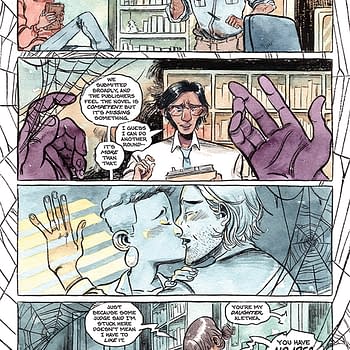Posted in: Comics, Recent Updates | Tagged: Adam Rex, children's books, Chu's Day, Chu's First Day of School, entertainment, HarperCollins, illustration, neil gaiman
Neil Gaiman And Adam Rex Capture The Charm Of Reading In Chu's First Day Of School
When Neil Gaiman and Adam Rex collaborated on their children's illustrated book Chu's Day, it climbed to the top of the New York Times Best-seller List with graceful ease, but it didn't really occur to me even then that there might be a sequel. It really should have given the talent of both parties and the strengths of the book. The original Chu's Day, which is varied in its carnival, home, and town settings, is a book about cuteness and strength, and perhaps even a little bit about forgiveness.
Now it's being followed by Chu's First Day of School. For those who have read the first book, the title itself will prompt a certain reaction that probably consists of involuntary widening of the eyes and a twitch of chagrin. This is because the whole premise of child Panda Chu's story is that his sneezing is capable of pretty much destroying the world. Or at least his corner of it at any given time in a way that causes some consternation for adults.
Unsurprisingly, Chu is nervous about going to school for the first time, but Gaiman gently brings that down to earth in his prose by focusing on the typical stresses of whether other children will "like" Chu rather than hammering home the dangers of his abilities other than opening with the hint that "There was a thing that Chu could do" in opening. That ambiguous introduction also means that those who haven't read the first book will be in for plenty of surprises in this volume.
Many have praised Gaiman as a master of short-form prose as well as commenting on the density of his carefully constructed longer works (which read, to all intents and purposes as stories composed of the same intermeshing tensile fabric of his short works with greater layering and therefore greater reach), and paring things down to the often single-line narrative statements in Chu's First Day of School gives adult fans a chance to see this craftsmanship under a microscope. It leaves me remembering that there are so many things he could possibly say on each page, and yet he hasn't. His choices are a matter of interest and twitch with a kind of mellow humor that can easily be brought out when read aloud to children.
It's also quite evident that Gaiman is a writer of comics when perusing this new book for one simple reason: he allows Adam Rex to tell half, if not more, of the story, a goal that more illustrated book should strive for to bring out the full storytelling abilities of artists. Rex was already a New York Times Best-selling author/illustrator before working on the first appearance of Chu, and so had formed his own sense of how text and illustration work in tandem. He has a fine sense of when to load a double-page spread with detail, some of which may only be noticed after long, appreciative pauses, and when to give images a minimalist isolation. A trope Rex established in Chu's Day carries on in this new work, that of presenting the adorable Chu "floating" in white space, which only further accentuates his facial expressions and body language. The fact that he can create body language in a rolly-polly bundle of fur, by the way, should stand as a testament to his skills.
Two things Rex does that particularly highlight his illustrative gusto in this book are, firstly, that among a fairly large cast of characters, he designs different facial expressions and reactions appropriate to these animal species in each instance. The other I'll be fairly vague about, but involves a double, double-page spread (that's two consecutive double page spreads) where the details change. What may at first seem an exercise in simplicity when constructing a spacious children's story is, in fact, far from it. Like a Haiku, each of Rex's lines (or brush-strokes) count and like Gaiman, he's making careful choices.
It should be obvious by now that I'm recommending this book to readers. But who am I recommending it to? Well, everyone. It's a work of art. For adults, it is something enjoyable to give a close reading to, and does serve as a great exemplar of how good storytelling works, but of course if you have children in your life, there are double reasons to have it in your possession. On the same day that Chu's First Day of School will be available in shops (June 24th), HarperCollins are also releasing a "board book" of Chu's Day, and looking through it emphasizes the many potentials of these stories for young readers. Chu's Day "works" in board book format for very young children. To me, that means that the prose and illustrations work well enough together to be an early primer for children at the pre-reading but reading-curious level.
As mentioned above, these narratives work very well when read aloud. But in the larger format hardbacks, they will also enable children to advance their reading skills by reaching a point where they can read aloud or read to themselves. That's the kind of fine line in the narrative construction that the Chu books achieve demonstrating how versatile they are as children's books. That suggests to me that a great deal of thought went in to creating a multi-level reader experience in these books that's all about accessibility. The books are unutterably charming, but they are also incredibly useful in introducing children to the charm of reading with themes that will prompt thought, discussion, and an appetite for visual storytelling in the future.
And actually, HarperCollins have conveniently provided a sampler to preview the book, so have a look for yourself too:
Hannah Means-Shannon is EIC at Bleeding Cool and @hannahmenzies on Twitter
















